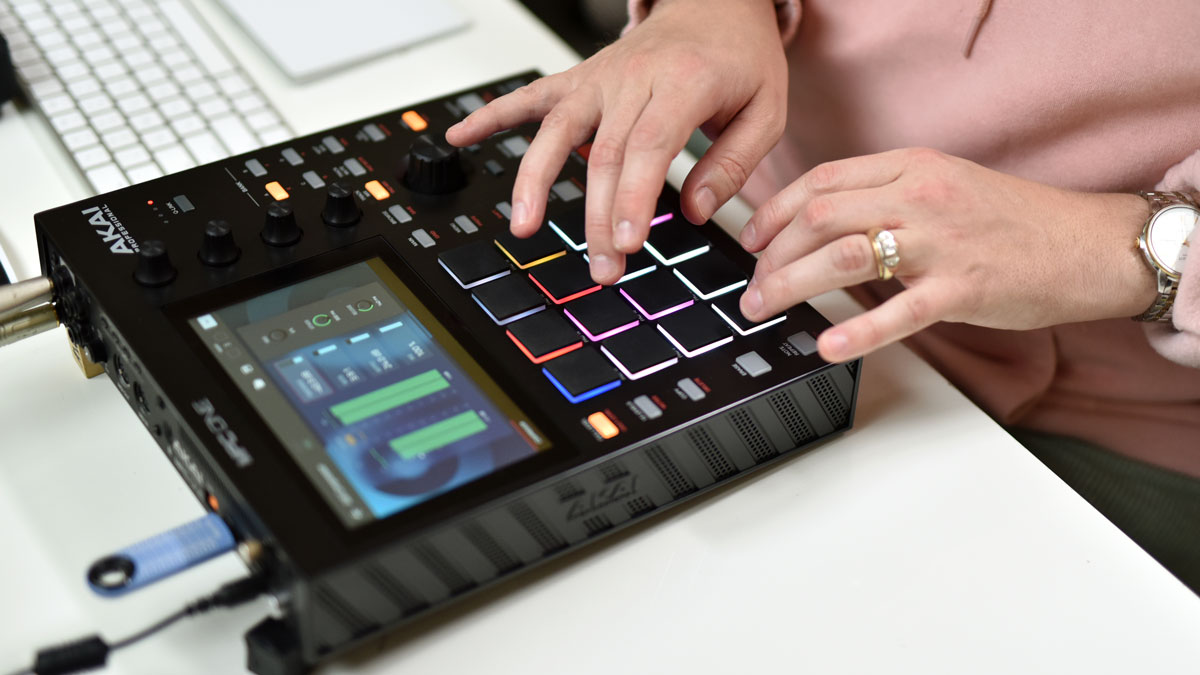Long before digital audio workstations (DAWs) took the studio production world by storm, the AKAI Professional MPC was already making history as one of the most advanced digital sequencers of its era. With 16 touch pads and an endless world of sampling a button push away, early adopters of the MPC included Warren G, J Dilla and many other cornerstones of hip-hop and popular music.
The Akai Professional MPC One is the next generation of standalone production—harnessing the power of the MPC Live and MPC X’s multi-core processor. “With the MPC X and the MPC Live, the MPC returned to standalone, and MPC One is the next step. It’s a more accessible price point, but shares the same software as its larger brethren,” says Akai Professional Senior Product Manager Daniel Gill.
In designing the next iteration of the MPC standalone controller, Gill and the AKAI Professional team hoped to expand the audience for the original MPC, which has built a reputation over the last several decades as an industry standard for sampling and production. “It was our desire to bring the MPC platform as a whole to more of the masses,” explains Gill. “This wasn’t really possible a few years ago, but now the technology is there.”
Featuring a reimagined MPC 2 Software that drives both standalone and controller modes, the MPC One production suite combines 128-track sequencing with real-time stretching, clip-launch functionality, sampling and audio editing/recording, and much more. Plus, stay connected to your library with an upgraded, multi-touch 7" high-resolution display and MPC’s classic velocity-sensitive RGB pads, each with assignable colors for optimized control. “Ergonomically, it’s the best for playing finger drums, as you can have access to a full kit of sounds without moving your hand position,” says Gill.

Machinedrum demos the Akai MPC One.
Keeping in line with the MPC tradition of personalized workflow, the MPC One offers enhanced features producers are used to. “Editing audio, being able to actually draw your MIDI parts, even the XY pad are all much more fun on a touchscreen than a smaller LCD,” says Gill. “The MPC One has a lot of direct access buttons, which harkens back to the old-school MPCs, which a lot of people love.”
The MPC One also marks one of the most studio-compatible controllers to date, adding a CV/gate for external connectivity to modules and racks. “As a fully standalone MPC, the MPC One is more than capable of being the center of your DAW-less setup,” explains Gill. “MIDI, CV and sampling can all be controlled on the fly with the MPC One’s 128 tracks for MIDI, drums, CV, MPC plug-ins and eight stereo tracks of audio.”
Loaded with all-new drum samples and a loop library with sounds from leading designers like RawCutz, Sample Tools by CR2 and others, you can jump right into production mode without skipping a beat. You can enhance tracks with signature synth engines, like Electric, Tubesynth and Bassline. “The MPC One has the ability to be a centerpiece in your hardware setup, as well as a powerful tool that can work beside your DAW,” explains Gill. “MPC One can work as a controller for MPC Software, so you can have the MPC software running as a VST/AU/AAX in your favorite DAW and have your MPC projects sync perfectly.”
No stranger to the MPC line of controllers, we invited producer Travis Stewart (known by his Machinedrum alias) to check out the new MPC One and share his first impressions. “It’s nice that the MPC One is standalone, so I can step away from the computer, go into the living room—it’s a different kind of workflow that brings different kinds of inspirations,” says Stewart. “It’s easy to dive in and instantly start creating.”
After studying audio engineering in college, Stewart made a name for himself early on in the electric music world as a pioneer of the glitch-hop genre, seamlessly blending hip-hop beats with electronic-heavy soundscapes. He eventually went on to form collaborations like Sepalcure (with Praveen Sharma), JETS (with Jimmy Edgar) and an expansive collection of solo albums. Many of Machinedrum’s collaborations are defined by fully-immersive universes, like the release of his Vapor City LP, which included an interactive website, digital citizenship program for fans, and even an NYC art exhibit alongside the launch of the album.
For Stewart, maintaining total freedom within creative mediums is crucial for collaborations, both with other artists and within the capabilities of the instrument itself. “Having music technology, from the computer to the MIDI controller to regular drum machines, has given me and many other musicians unlimited opportunities to create different sounds that come from the mind,” says Stewart. “There are so many tools at our fingertips now that allow us to express ourselves in ways we couldn’t have before and it’s creating infinite possibilities within music, which is really exciting to see.”
Now, more than ever, producers like Machinedrum have the capacity to create without limitations, with the MPC One leading the movement as Akai Professional’s most advanced MPC unit to date. Complete with upgraded software and sample libraries, expanded compatibility and connectivity, and an affordable price tag, it’s the ideal choice addition for any producer’s studio setup.
Learn more about the Akai Professional MPC One.
Keep up with Machinedrum on Instagram.







